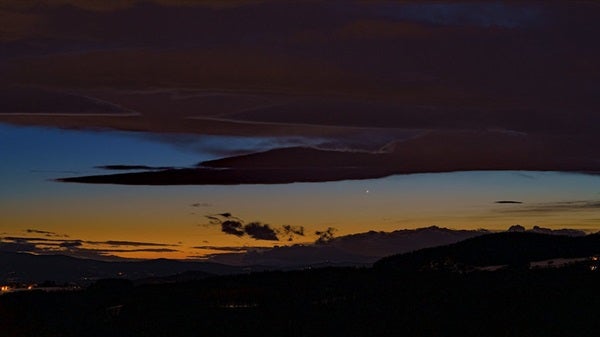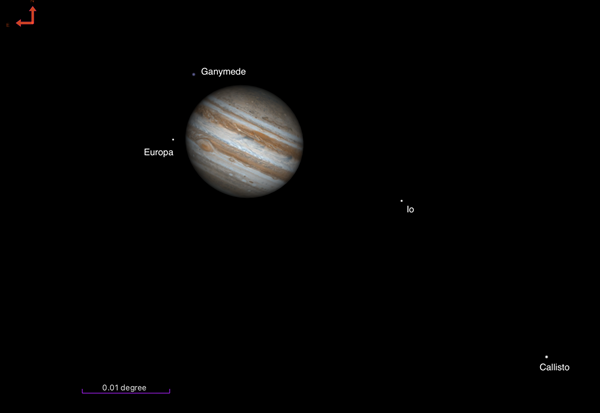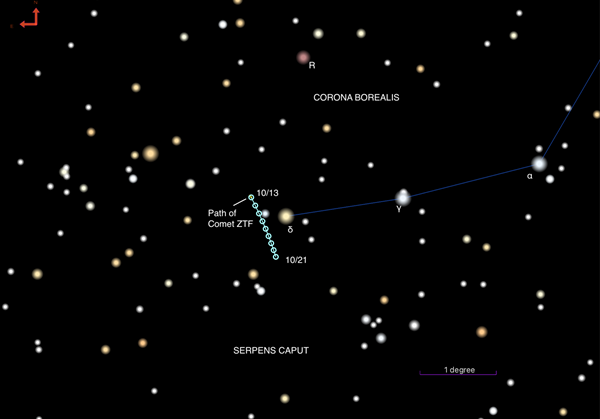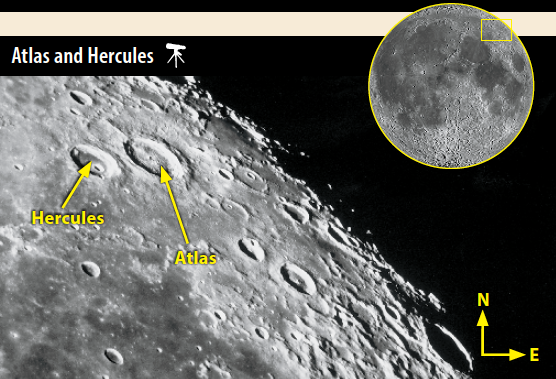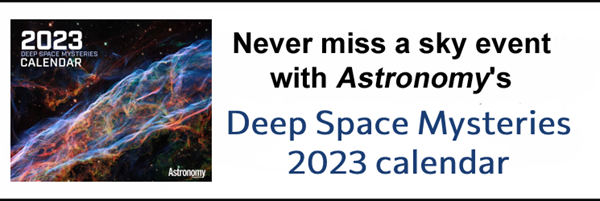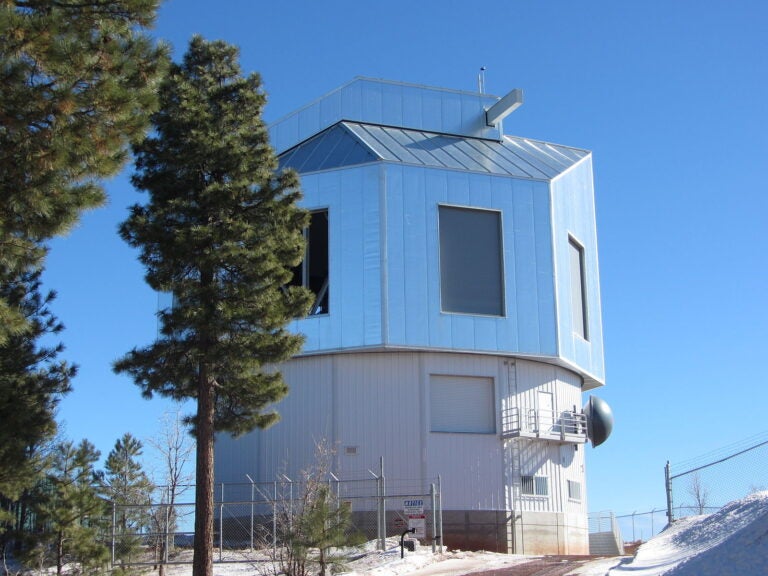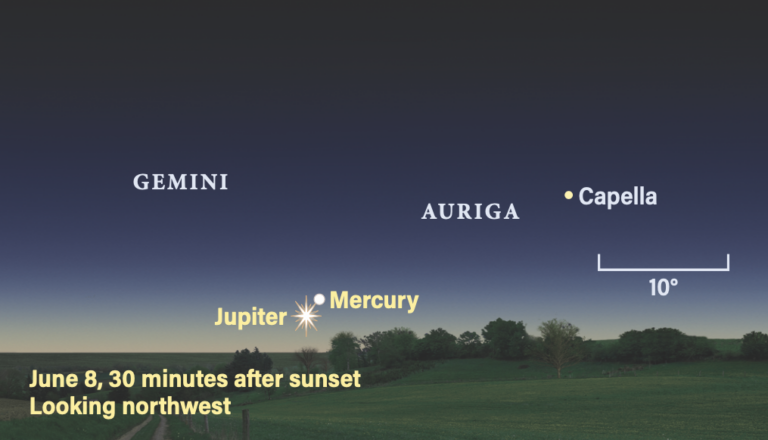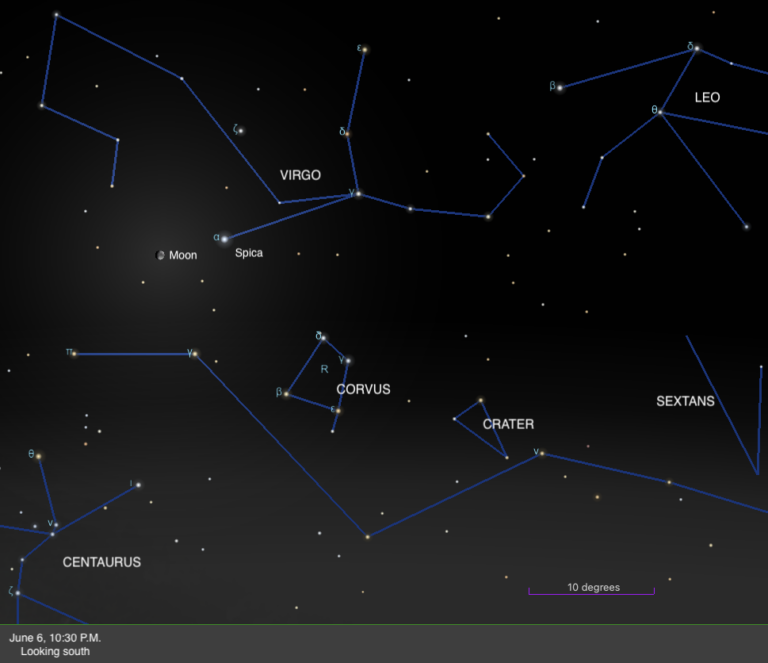Friday, October 7
Asteroid 4 Vesta is stationary at 2 A.M. EDT. Currently in Capricornus, the main-belt world will now start moving northeast toward Aquarius, where our targets for tonight lie.
In the evening sky, the Moon will pass 3° south of Neptune at 11 P.M. EDT. Both are visible after sunset in northeastern Aquarius, near where the constellation’s border with Pisces. At magnitude 7.7, you’ll need binoculars or a telescope to make out Neptune’s small disk; it may prove a challenge with the bright, nearly Full Moon so close by.
Easier to find may be the magnitude 1.2 glow of Fomalhaut, the brightest star in Piscis Austrinus, which sits south of Aquarius. An hour after sunset, it is 6.5° high in the southeast and rising. Of course, those in the Southern Hemisphere enjoy this star at a much higher altitude in the sky. Fomalhaut is a young star some 25 light-years away. It is perhaps most famous for its protoplanetary disk, within which astronomers believed they’d spotted a young planet with the Hubble Space Telescope. But in 2014, that planet disappeared — and researchers realized it had never been a planet at all, but likely the icy remains of a massive collision that previously took place within the disk.
Sunrise: 7:02 A.M.
Sunset: 6:32 P.M.
Moonrise: 5:51 P.M.
Moonset: 4:18 A.M.
Moon Phase: Waxing gibbous (94%)
*Times for sunrise, sunset, moonrise, and moonset are given in local time from 40° N 90° W. The Moon’s illumination is given at 12 P.M. local time from the same location.
Saturday, October 8
The distant dwarf planet Pluto is stationary at 2 P.M. EDT in northeastern Sagittarius. Unfortunately, because it is so small and faint, its feeble light will be difficult to find even with a large amateur scope because the Moon is so bright. We’ll revisit this tiny target when conditions are better.
The Moon passes 2° south of Jupiter at 2 P.M. EDT — and at magnitude –2.9, this is a much better target for tonight. There’s a lot going on around the king of planets, too. Around 8:50 P.M. EDT, Europa is passing onto the disk from the east. Less than 10 minutes later, Ganymede appears about 20″ from the eastern limb, emerging from long shadow that stretches behind the planet. And speaking of shadows, Europa’s trails onto the cloud tops around 9:25 P.M. EDT, following the moon from east to west.
Just before 10:45 P.M. EDT, Io disappears behind Jupiter’s western limb in an occultation. About half an hour later, Europa leaves the western edge of the disk; its shadow follows about 45 minutes later. Io won’t reappear until tomorrow morning for those in the eastern half of the U.S., emerging from the shadow just as Ganymede did, to Jupiter’s east, around 1:15 A.M. EDT on the 9th. The entire time, Callisto sits far to Jupiter’s west, staying out of the theatrics.
Mercury reaches greatest western elongation at 5 P.M. EDT, when it stands 18° from the Sun. We’ll catch up with this planet in just a few hours, early tomorrow morning.
Sunrise: 7:03 A.M.
Sunset: 6:31 P.M.
Moonrise: 6:15 P.M.
Moonset: 5:30 A.M.
Moon Phase: Waxing gibbous (98%)
Sunday, October 9
Mercury rises about 90 minutes before the Sun; an hour before sunrise, the solar system’s smallest planet is 5° high in western Virgo. Still a bright magnitude –0.5, through a telescope, Mercury appears 55 percent lit and 7″ across.
It’s not the only bright light in the sky before dawn steals the dark away. Some 28° west of Mercury is magnitude 1.4 Regulus, the heart of Leo the Lion. Look another 37.5° west, and you’ll hit magnitude 0.4 Procyon, the brighter of the two main stars that make up Canis Minor. And, of course, nearby is the brightest star in the sky: magnitude –1.4 Sirius, some 26° southwest of Procyon. Watch the eastern sky as it grows lighter; which stars disappear first, and which can you follow the longest?
Full Moon officially occurs at 4:55 P.M. EDT. October’s Full Moon is also known as the Hunter’s Moon. Our satellite now lies in southeastern Pisces, some 17° east of Jupiter. The Moon will continue to look nearly Full through Tuesday, dominating the sky after dark.
Sunrise: 7:04 A.M.
Sunset: 6:29 P.M.
Moonrise: 6:39 P.M.
Moonset: 6:39 A.M.
Moon Phase: Full
Monday, October 10
Now that the Moon has moved away from Capricornus, let’s return to this constellation to try our luck at spotting 4 Vesta. Although it’s started to move away, tonight, the magnitude 6.8 world still sits near the globular cluster M30. They are separated by just 3°, with Vesta east-northeast of the dense ball of stars.
At magnitude 7.2, M30 is just a tad fainter than the asteroid. It spans some 12′ across, which translates to a physical diameter of about 90 light-years at its vast distance some 26,000 light-years from Earth. M30 appears particularly dense, with a bright, tightly packed core and sparse outskirts. Even a small telescope should show this faint fuzzball, though you’ll likely want to opt for a larger aperture if possible, as the bright Moon is still throwing its light across the sky. And although Vesta is moving away, it will stay within 5° of M30 for most of the rest of the month. So, if this view isn’t one you can capture tonight, there will be plenty of chances to return before they draw too far apart to easily enjoy together.
Sunrise: 7:05 A.M.
Sunset: 6:28 P.M.
Moonrise: 7:04 P.M.
Moonset: 7:48 A.M.
Moon Phase: Waning gibbous (99%)
Tuesday, October 11
Observers in the northwestern U.S. and parts of Canada and Greenland get a special treat tonight: Uranus is occulted by the Moon. The magnitude 5.7 planet will be a challenging to see with the bright Moon so close by, but bring out your binoculars or telescope to give it a try. It’ll certainly be worth it.
The pair rise around 7:30 P.M. local time in Aries the Ram. Uranus currently sits about halfway between 6th-magnitude Sigma (σ) and 53 Arietis. You’ll need to stay up late to catch the event, as it takes several hours for the Moon to close in on the ice giant’s position. The times of the occultation’s start and end are heavily location dependent, occurring late on the 11th or early on the 12th. Check the International Occultation Timing Association’s page for the event to find out whether your location is in the path of the shadow and when to look for Uranus to disappear and return to the sky.
Even if you can’t observe the occultation, you can certainly watch the distance between the planet and our satellite shrink. In the early hours of the 12th, the Moon will pass less than a degree north of Uranus.
Sunrise: 7:07 A.M.
Sunset: 6:26 P.M.
Moonrise: 7:31 P.M.
Moonset: 8:55 A.M.
Moon Phase: Waning gibbous (96%)
Wednesday, October 12
Following an occultation visible from some parts of the U.S. (see yesterday’s entry for more details), the Moon passes 0.8° due north of Uranus at 3 A.M. EDT. Both remain in southeastern Aries all morning as the Moon pulls ever farther away. Uranus, currently magnitude 5.7, will remain a bit challenging with binoculars or a small scope but if you do spot it, look for the bluish-gray color of its small, 4″-wide disk.
For those who aren’t early risers, we’ve got a tantalizing target in the evening sky. The stunning double star Albireo flies high in the east after sunset. Marking the head of Cygnus the Swan, Albireo (Beta [β] Cygni) appears as a single 3rd-magnitude star to the naked eye. But a small telescope splits it into two components with magnitudes of 3.3 and 5.5. They’re widely separated by 24″ and easy to separate even at low power. What will really catch your eye, though, is their contrasting colors of yellow-orange and blue-white.
These two stars are likely not an actual binary pair. If they were gravitationally bound, their orbit would be so wide that it would take 75,000 years to circle each other once. However, the brighter, yellow-hued star, cataloged as Albireo A, is a binary with a companion. They take about 100 years per orbit; these two, however, are not easy to split and will appear as a single star in your telescope.
Sunrise: 7:08 A.M.
Sunset: 6:25 P.M.
Moonrise: 8:01 P.M.
Moonset: 10:03 A.M.
Moon Phase: Waning gibbous (91%)
Thursday, October 13
There’s an up-and-coming player on the celestial stage: Comet C/2022 E3 (ZTF) is predicted to peak brighter than 6th magnitude in early 2023, maybe even becoming the best comet of the year. For now, it’s about 11th magnitude and best seen with a larger (8 inches) amateur scope.
Catch the comet early — as soon as it gets dark after sunset and before the Moon has risen too high (or at all). This week, ZTF is floating in Corona Borealis, which is slowly setting in the west. The comet is just 0.5° northeast of 5th-magnitude Delta (δ) Coronae Borealis tonight. Over the next week, ZTF will fly in a straight line southwest past Delta, heading for Serpens Caput.
Nearby is ruby-red R Coronae Borealis, which sits about 2° north of Delta. R Cor Bor is a variable star that usually glows around 6th magnitude. Sometimes, though, it sputters, fading by a few magnitudes before returning to its original brightness in a few weeks or months. But other times its brightness drops dramatically, slipping as low as 14th magnitude! Astronomers aren’t entirely sure what causes the star’s wild, irregular variability, though they have some ideas, ranging from the star finally running out of fuel for fusion to the release of carbon-rich clouds that shroud the star and block its light. Compare R Cor Bor to the stars around it and see how bright you think it’s shining tonight.
Sunrise: 7:09 A.M.
Sunset: 6:23 P.M.
Moonrise: 8:35 P.M.
Moonset: 11:08 A.M.
Moon Phase: Waning gibbous (85%)
Friday, October 14
Late tonight, the Moon and Mars hang together between the horns of Taurus the Bull. Mars is now magnitude –0.8 and spans 13″. Its disk is 90 percent lit. The Red Planet is approaching opposition later this year, growing larger and brighter with every passing week. By the end of the month, it will reach 94 percent lit and stretch 15″ across.
Focus in on the Moon with a telescope and look for the large crater Aristoteles, which sits in the north above the large, dark Sea of Serenity. Under this Sun angle, the terrain around Aristoteles appears rough and textured, the level of detail limited only by your local seeing conditions. Look especially at the crater’s western rim, where a small crater has scooped out a portion of its material. As a result, the shadow falling on the crater floor looks like it’s had a small bite taken out of it.
Just west of Aristoteles is the straight line of Vallis Alpes, which runs through the Montes Alpes mountain range. Above (north of) this valley is the circular crater Protagoras, half-lit and half in shadow as the Sun sets over the lunar landscape.
Sunrise: 7:10 A.M.
Sunset: 6:22 P.M.
Moonrise: 9:16 P.M.
Moonset: 12:11 P.M.
Moon Phase: Waning gibbous (77%)

